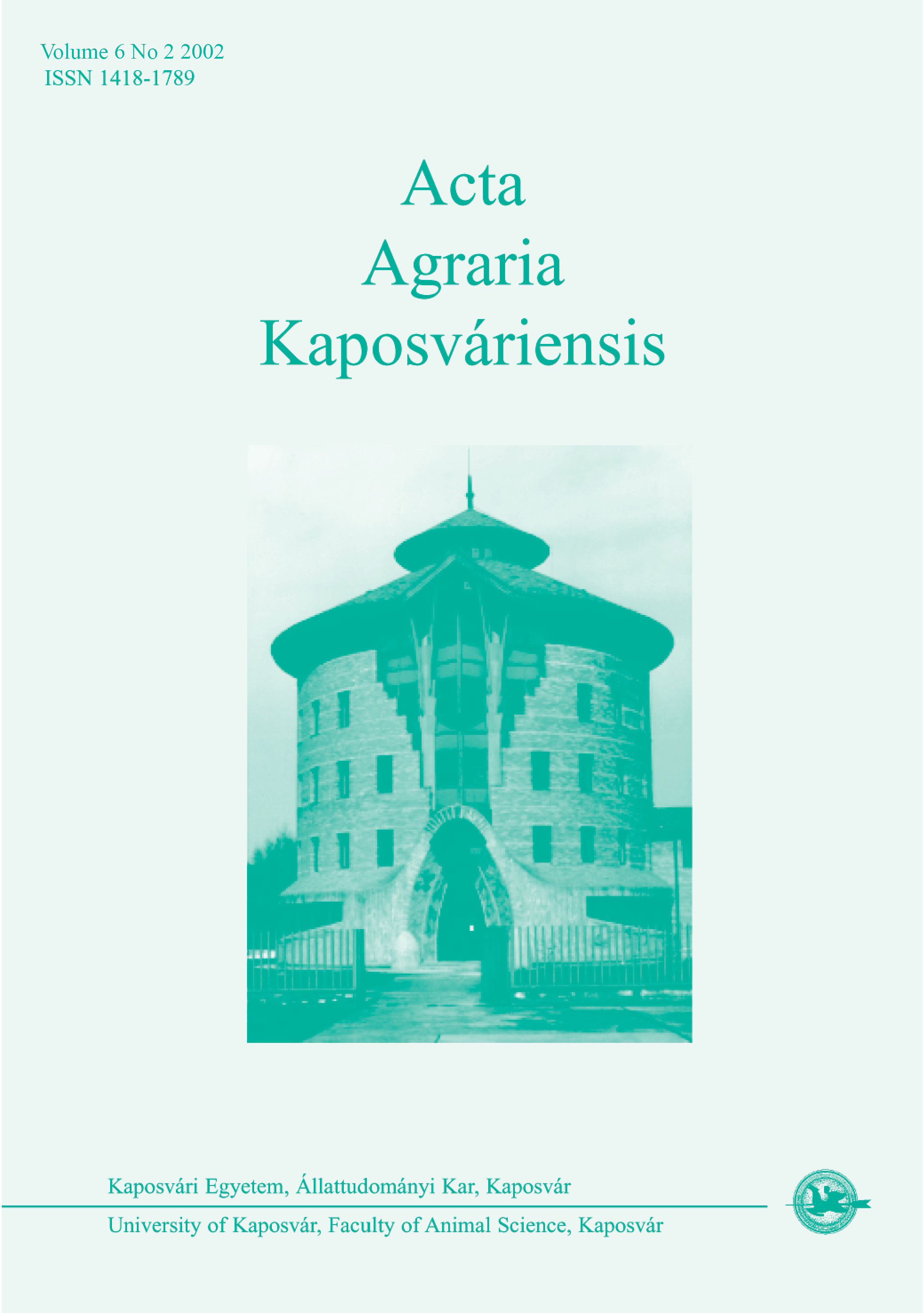Effect of selection on the body fat content of rabbits by means of the TOBEC method on the body composition and slaughter traits of their offspring
Kulcsszavak:
rabbit, fat, TOBEC, selection, body compositionAbsztrakt
The aim of this study was to clarify’ the usefulness of TOBEC method in the selection of body fat content of the rabbits. For this purpose rabbits of average ± 1 S.D. live weight at 10 weeks and of average ± 1 S.D. daily weight gain between 6 and 10 weeks of age were chosen from the experimental stock of the university, and their fat content was determined with an EM-SCAN SA-3152 type small animal body composition analyser (by means of TOBEC method). Based on the fat content determined the best and worst 16% of the does and the best and worst 8% of the bucks were chosen and mated with each other (fatty doe with fatty buck and lean doe with lean buck). In the body fat content of the offspring significant differences were observed at 10 weeks of age (9.7 in the fatty and 7.1 in the non-fatty rabbits). Next to the fat content also the liver (3.0 and 2.1%) and other edible organs (2.3 and 1.8%) showed higher values in the offspring of fatty rabbits. In spite of these a higher ratio of the carcass was observed in the non-fatty animals (49.8 and 52.3%, respectively). Due to the higher ratio of the carcass, the protein content of the body was also higher in these rabbits (18.7 and 19.3%). Based on the results, the TOBEC method for the selection of rabbits based on their body fat content seems to be useful.
Hivatkozások
Blasco, A., Ouhayoun, J., Masoero, G. (1993). Harmonization of criteria and terminology in rabbit meat research. World Rabbit Science, 1(1), 3–10. https://doi.org/10.4995/wrs.1993.189
Cunningham, J., Molnar, J., Meara, P. A., Bode, H. H. (1986). In vivo total body electrical conductivity (TOBEC) following perturbations of body fluid compartments in rats. Metabolism, 35(6), 572–575. https://doi.org/10.1016/0026-0495(86)90017-X
Fekete, S. (1992). The rabbit body composition: Methods of measurement, significance of its knowledge and the obtained results - a critical review. J. App. Rabbit Res., 15. 72–85.
Fekete, S., Brown, D. L. (1993). The major chemical components of the rabbit whole body measured by direct chemical analysis, deuterium oxide dilution and total body electrical conductivity. J. Vet. Nutr., 2. 23–29.
Fekete, S., Kósa, E., Andrásofszky, E., Hullár, I. (1995). In vivo measurements of body composition of dwarf and normal rabbit. 9th Symposium on Housing and Diseases of Rabbits, Furbearing Animals and Fancy Pet Animals, Celle, 223–234.
Fiorotto, M. L., Cochran, W. J., Funk, R. C., Sheng, H-P., Klish, W. J. (1987). Total body electrical conductivity measurements: effect of body composition and geometry. Am. J. Physiol. 252(4), R794–R800. https://doi.org/10.1152/ajpregu.1987.252.4.R794
Kövér, Gy., Szendrő, Zs., Romvári, R., Jensen, J. F., Sørensen, P., Milisits, G. (1998). In vivo measurement of body parts and fat deposition in rabbits by MRI. World Rabbit Science, 2. 231–235.
Milisits, G. (1998). Növendék- és anyanyulak testösszetétel változásának vizsgálata komputer tomográffal és TOBEC módszerrel. Doktori (PhD) értekezés, Kaposvár, 124.
Milisits, G., Gyarmati, T., Szendrő, Zs. (1999). In vivo estimation of body fat content of new-born rabbits using the TOBEC method. World Rabbit Science, 3. 151–154.
Milisits, G., Romvári, R, Dalle Zotte, A., Szendrő, Zs. (1999). Non-invasive study of changes in body composition in rabbits during pregnancy using X-ray computerized tomography. Annales de Zootechnie, 48(1), 25–34. https://doi.org/10.1051/animres:19990103
Milisits, G., Szendrő, Zs., Mihálovics, Gy., Biró-Németh, E., Radnai, I., Lévai, A. (2000). Use of the TOBEC method for predicting the body composition of growing rabbits. 7th World Rabbit Congress, Valencia, 1. 637–642.
Romvári, R. (1996). A komputeres röntgen tomográfia alkalmazásának lehetőségei a húsnyúl és brojlercsirke testösszetételének és vágási kitermelésének in vivo becslésében. Doktori (PhD) értekezés. Pannon Agrártudományi Egyetem, Állattenyésztési Kar, Kaposvár.
Romvári, R., Szendrő, Zs., Horn, P. (1994). A hús- és a zsírszövet beépülésének követése CT-vel 0.5 és 3.5 kg közötti nyulakban. 6. Nyúltenyésztési Tudományos Nap, Kaposvár, 80–85.
SPSS for Windows (1999). Version 10.0, Copyright SPSS Inc.
Staudinger, F. B., Rorie, R. P., Anthony, N. B. (1995). Evaluation of a noninvasive technique for measuring fat-free mass in poultry. Poultry Sci., 74(2), 271–278. https://doi.org/10.3382/ps.0740271
Szendrő, Zs., Horn, P., Kövér, Gy., Berényi, E., Radnai, I., Biróné Németh, E. (1992). In vivo measurement of the carcass traits of meat type rabbits by X-ray computerised tomography. J. Appl. Rabbit Res., 15. 799–809.
Szendrő, Zs., Milisits, G., Romvári, R., Lévai, A., Gyarmati, T., Radnai, I., Biróné Németh, E. (1998). A házinyúl testösszetételének vizsgálata TOBEC módszerrel: 1. Anyanyulak. 10. Nyúltenyésztési Tudományos Nap, Kaposvár, 107–114.
Szendrő, Zs., Romvári, R., Horn, P., Radnai, I., Biróné Németh, E. (1994). A vágóértékre történő szelekció CT-vel. 6. Nyúltenyésztési Tudományos Nap, Kaposvár, 96–105.
Van Loan, M., Mayclin, P. (1987). A new TOBEC instrument and procedure for the assessment of body composition: use of Fourier coefficients to predict lean body mass and total body water. Am J. Clin Nutr., 45(1), 131–137. https://doi.org/10.1093/ajcn/45.1.131
Letöltések
Megjelent
Folyóirat szám
Rovat
License
Copyright (c) 2002 Milisits Gábor, Lévai András

This work is licensed under a Creative Commons Attribution-NonCommercial-NoDerivatives 4.0 International License.






